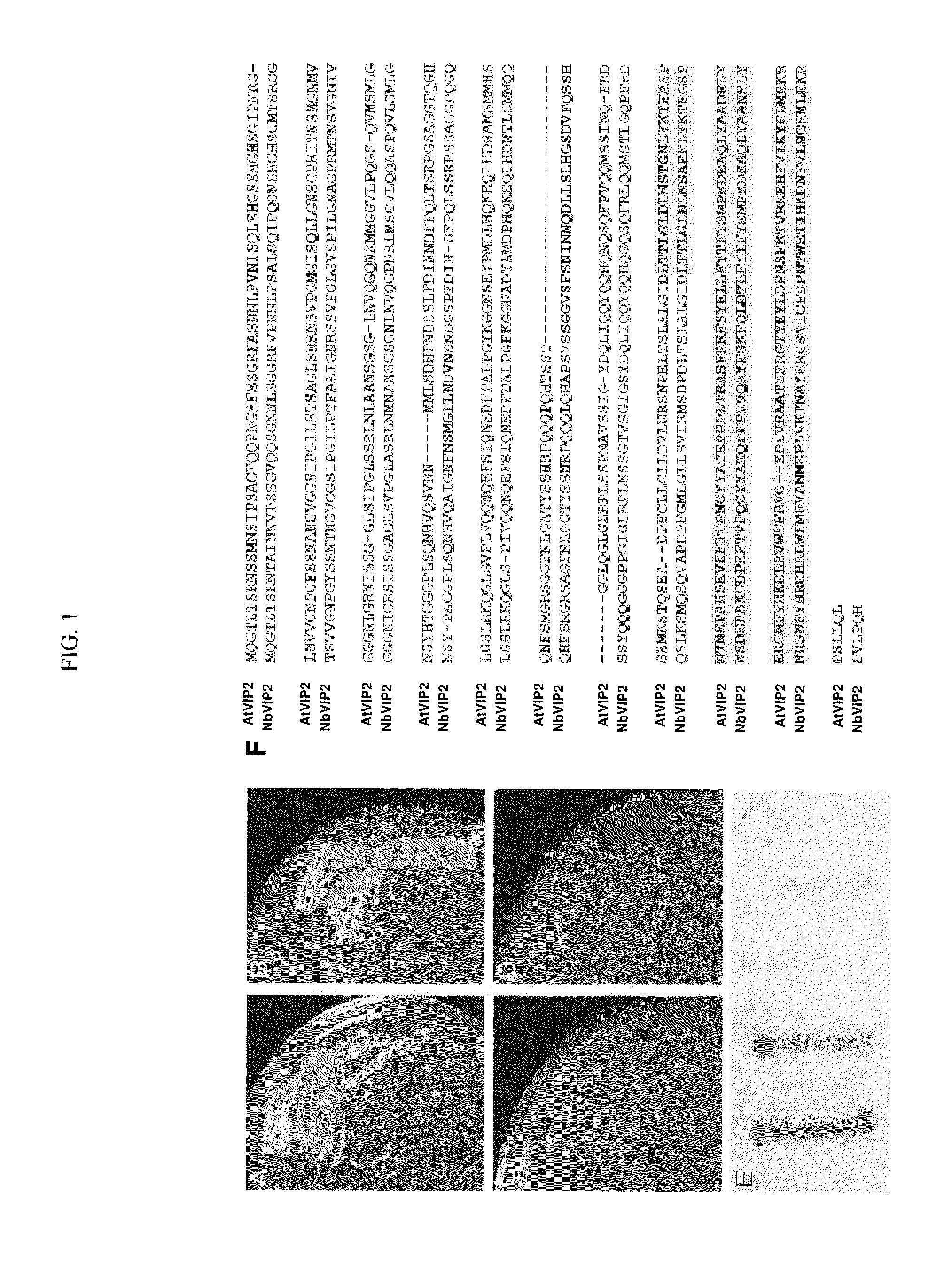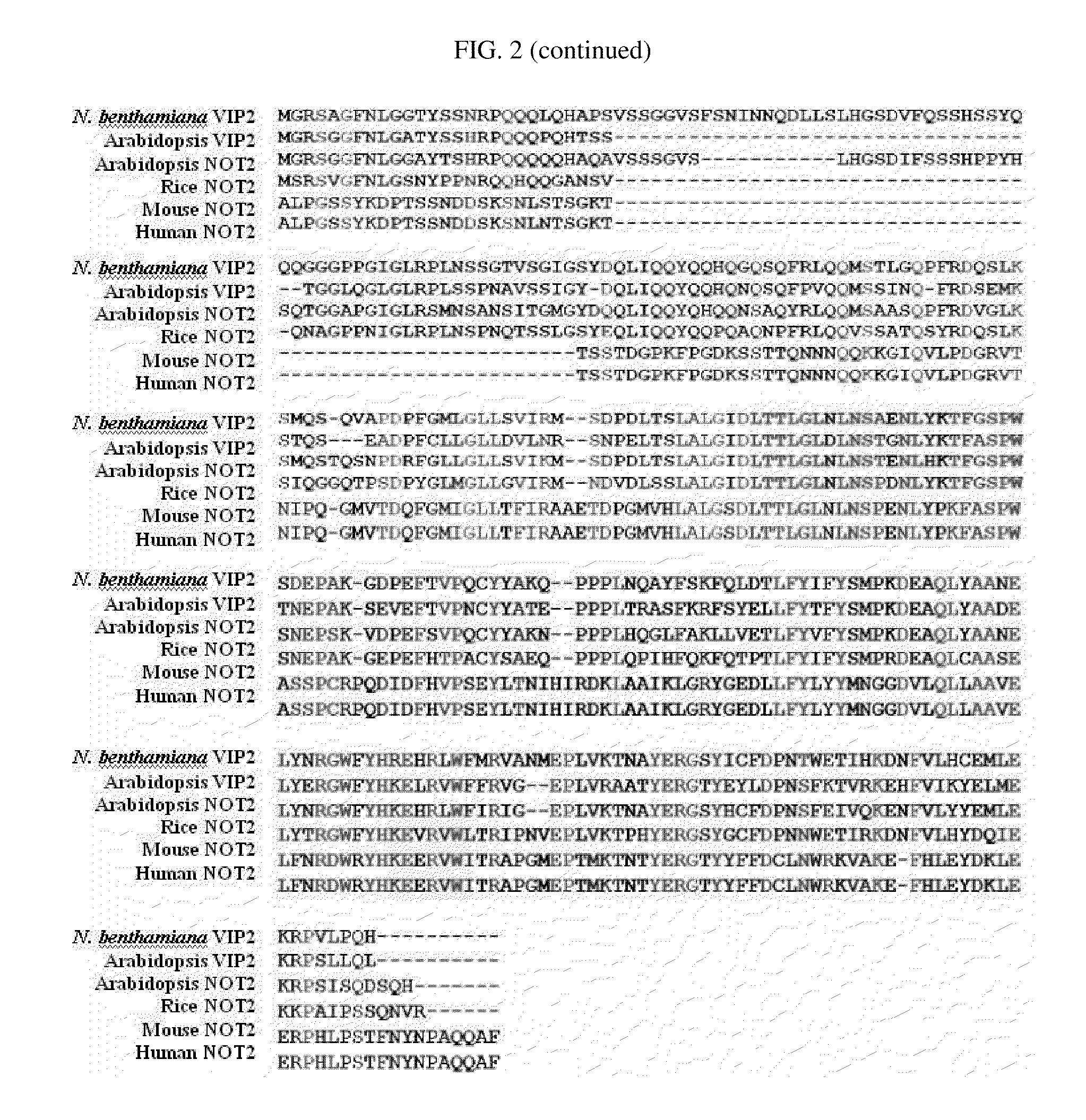Method for agrobacterium-mediated transformation of plants
a technology of agrobacterium and plant, applied in the field of molecular biology, can solve the problems that the methods of utilizing vip2 to enhance such dna transfer have not been known, and achieve the effect of increasing the efficiency of transformation
- Summary
- Abstract
- Description
- Claims
- Application Information
AI Technical Summary
Benefits of technology
Problems solved by technology
Method used
Image
Examples
example 1
Materials and Methods
[0170]Yeast two-hybrid assays were carried out as previously described ((Lin et al., 2002). In particular, Saccharomyces cerevisiae strain L40 {MATa his3Δ200 trp1-901 leu2-3,112 ade2 lys2-801am URA3::(lexAop)8-lacZ LYS2::(lexAop)4-HIS3} (Hollenberg et al., 1995) was grown in yeast extract / peptone / dextrose (YPD) or the appropriate selective minimal medium using standard conditions (Kaiser et al., 1994). Plasmids were introduced into yeast cells using a standard lithium acetate protocol (Kaiser et al., 1994). Arabidopsis thaliana (ecotype Colombia) cDNA library in pGAD424 (LEU3+, Clontech, Mountain View, Calif., USA) (Ballas and Citovsky, 1997) was screened with pBTM116-VirE2 (Tzfira et al., 2001) as bait as described (Hollenberg et al., 1995; Ballas and Citovsky, 1997; Tzfira et al., 2001) and positive clones were selected on a histidine-deficient selective medium and confirmed by the β-galactosidase assay as described (Durfee et al., 19...
example 2
Identification of AtVIP2
[0189]VIP2 and VIP2-like proteins contain a conserved C-terminal domain of NOT2 / NOT3 / NOT5 (negative on TATA-less) proteins (FIG. 1F). NOT2 / NOT3 / NOT5 domain containing genes were identified from Saccharomyces cerevisiae via genetic screens for increased transcription from TATA-less promoters (Oberholzer and Collart, 1998; Collart, 2003). The NOT proteins are an integral component of the CCR4 (carbon catabolite repression) transcriptional complex sharing overlapping functions (Liu et al., 1998) and are believed to be involved in both positive and negative regulation of gene expression in yeast (Collart, 2003; Collart and Timmers, 2004). The yeast Not2p and Drosophila Rga proteins that contain NOT domains are well studied and are thought to mediate intranuclear interactions between chromatin components and the transcriptional complex (Collart, 2003; Collart and Struhl, 193; Frolov et al., 1998). VirE2-interacting proteins (VIPs) were identified using the yeast t...
example 3
NbVIP2 is Induced by Agrobacterium Infection
[0192]The NbVIP2 gene was induced up to two-fold following 12 h post infection (hpi) with both an avirulent A. tumefaciens strain A136 (lacks Ti plasmid) and a T-DNA transfer competent strain A. tumefaciens GV2260 carrying pBISN1, when compared with the mock inoculated N. benthamiana (FIG. 5). NbVIP2 transcripts remained elevated up to 36 hpi in leaves inoculated with A136, but decreased to basal levels at 48 hpi. In the leaves infected with T-DNA transfer competent strain, elevated transcript levels of NbVIP2 were maintained up to 48 hpi and were 2-3 fold more than those detected in A136 infected leaves (FIG. 4). These results suggest that the transfer competent Agrobacterium strain induces VIP2 gene expression to a greater extent than the avirulent strain.
PUM
| Property | Measurement | Unit |
|---|---|---|
| length | aaaaa | aaaaa |
| temperature | aaaaa | aaaaa |
| humidity | aaaaa | aaaaa |
Abstract
Description
Claims
Application Information
 Login to View More
Login to View More - R&D
- Intellectual Property
- Life Sciences
- Materials
- Tech Scout
- Unparalleled Data Quality
- Higher Quality Content
- 60% Fewer Hallucinations
Browse by: Latest US Patents, China's latest patents, Technical Efficacy Thesaurus, Application Domain, Technology Topic, Popular Technical Reports.
© 2025 PatSnap. All rights reserved.Legal|Privacy policy|Modern Slavery Act Transparency Statement|Sitemap|About US| Contact US: help@patsnap.com



